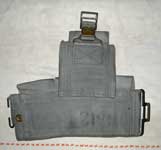Pattern 1925 Blue-grey Web Equipment - Equipment Carriers
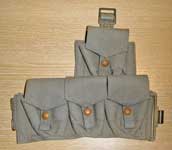
 The Pattern 1925 Cartridge carriers were introduced with the Web Equipment, R.A.F., Pattern 1925, under Air Ministry Weekly Order No. 793/1927, as Stores Ref. 23/77 (left) and 23/78 (right). The Carriers are mirror images of each other, and connect to the Adjusting strap. Each Carrier has four pockets, and each pocket holds 15 rounds of .303-inch ammunition in three 5 round chargers. This provides a total ammunition load of 120 rounds. This pair of Pattern 1925 Cartridge carriers were made on a Mills patent loom and have integrally woven cartridge pockets. These types of looms were used only by the Mills Equipment Company and M. Wright & Sons, Ltd. Compare this with the Canadian made "folded and sewn" Carriers shown just below.These Carriers are not maker marked or dated, but because of the construction they would have been manufactured by one of those two British firms.
The Pattern 1925 Cartridge carriers were introduced with the Web Equipment, R.A.F., Pattern 1925, under Air Ministry Weekly Order No. 793/1927, as Stores Ref. 23/77 (left) and 23/78 (right). The Carriers are mirror images of each other, and connect to the Adjusting strap. Each Carrier has four pockets, and each pocket holds 15 rounds of .303-inch ammunition in three 5 round chargers. This provides a total ammunition load of 120 rounds. This pair of Pattern 1925 Cartridge carriers were made on a Mills patent loom and have integrally woven cartridge pockets. These types of looms were used only by the Mills Equipment Company and M. Wright & Sons, Ltd. Compare this with the Canadian made "folded and sewn" Carriers shown just below.These Carriers are not maker marked or dated, but because of the construction they would have been manufactured by one of those two British firms.
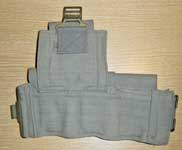
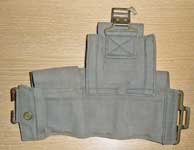 The rear views of the same pair of Cartridge carriers. In these views the upper four bar closed buckle can be seen. The Carrier itself attached to the lowest bar via a short web strap. After crossing over the shoulder, the Brace is threaded (from behind) over the bar second from top, back through the next lower one, and finally through the loop on the brass fitting connected directly to the Cartridge carrier. The upper bar on the buckle connects to the front hook of the Rucksack strap. This elaborate design was simplified in later equipment patterns.From the R.J. Dennis collection. Photos © Roger Dennis 2008.
The rear views of the same pair of Cartridge carriers. In these views the upper four bar closed buckle can be seen. The Carrier itself attached to the lowest bar via a short web strap. After crossing over the shoulder, the Brace is threaded (from behind) over the bar second from top, back through the next lower one, and finally through the loop on the brass fitting connected directly to the Cartridge carrier. The upper bar on the buckle connects to the front hook of the Rucksack strap. This elaborate design was simplified in later equipment patterns.From the R.J. Dennis collection. Photos © Roger Dennis 2008.

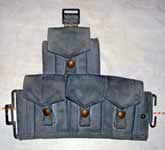 This pair of Cartridge carriers is unmarked and undated, but they are clearly Canadian made. The cartridge pockets are folded and sewn, rather than integrally woven like the British Mills Equipment Company ones. If you compare these Carriers with the British made examples shown above, the differences can be easily seen.
This pair of Cartridge carriers is unmarked and undated, but they are clearly Canadian made. The cartridge pockets are folded and sewn, rather than integrally woven like the British Mills Equipment Company ones. If you compare these Carriers with the British made examples shown above, the differences can be easily seen.
The rear views of the same pair of Cartridge carriers. From the Karkee Web Collection.
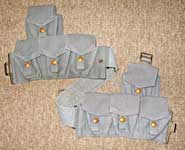
 Another pair of British made Cartridge carriers. The left Carrier is maker marked "M.E. Co." and dated 1928. The right Carrier bears an illegible contract mark and is dated 1938. From the Paul Skrebels Collection. Photographs © Paul Skrebels 2009.
Another pair of British made Cartridge carriers. The left Carrier is maker marked "M.E. Co." and dated 1928. The right Carrier bears an illegible contract mark and is dated 1938. From the Paul Skrebels Collection. Photographs © Paul Skrebels 2009.
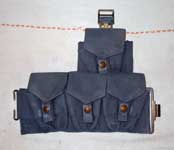
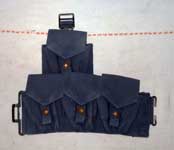 This pair of British made Carriers are not maker marked, but they are Air Ministry marked, contract marked "6694670/", and dated 1938. Curiously, the crown fastener spigot normally found on the left Carrier has been omitted on this example. Is this simply a manufacturing error, or was there a design change, for which we have not yet found any documentation? KW has not seen another left Carrier with a date this late. Can any reader help? From the Karkee Web Collection.
This pair of British made Carriers are not maker marked, but they are Air Ministry marked, contract marked "6694670/", and dated 1938. Curiously, the crown fastener spigot normally found on the left Carrier has been omitted on this example. Is this simply a manufacturing error, or was there a design change, for which we have not yet found any documentation? KW has not seen another left Carrier with a date this late. Can any reader help? From the Karkee Web Collection.
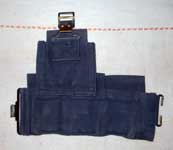
 Rear views of the same pair of Carriers.
Rear views of the same pair of Carriers.
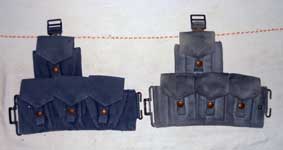
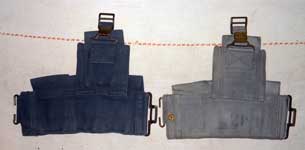 A comparison of the left Carriers from the British (far left) and Canadian (near left) pairs in the Karkee Web Collection. This comparison highlights the differences between integrally woven and folded and sewn Carriers.
A comparison of the left Carriers from the British (far left) and Canadian (near left) pairs in the Karkee Web Collection. This comparison highlights the differences between integrally woven and folded and sewn Carriers.

 The Pattern 1925 Bayonet Frog was introduced with the Web Equipment, R.A.F., Pattern 1925, under Air Ministry Weekly Order No. 793/1927, as Stores Ref. 23/61. Except for colour, it is identical to the W.E. Patt. '19 Infantry Equipment Bayonet frog and has the crown half of the fastener to attach it to either the left Cartridge carrier or the Back adjustment strap. It is designed to carry the Pattern 1907 Bayonet in scabbard. An almost identical Frog, in khaki and without the fastener, was used as the first variant of Frog issued with W.E. Patt. '37. This Canadian made example is maker marked "MS&U Ltd." (Montreal Suspender & Umbrella, Ltd.) and dated 1941. From the Karkee Web Collection.
The Pattern 1925 Bayonet Frog was introduced with the Web Equipment, R.A.F., Pattern 1925, under Air Ministry Weekly Order No. 793/1927, as Stores Ref. 23/61. Except for colour, it is identical to the W.E. Patt. '19 Infantry Equipment Bayonet frog and has the crown half of the fastener to attach it to either the left Cartridge carrier or the Back adjustment strap. It is designed to carry the Pattern 1907 Bayonet in scabbard. An almost identical Frog, in khaki and without the fastener, was used as the first variant of Frog issued with W.E. Patt. '37. This Canadian made example is maker marked "MS&U Ltd." (Montreal Suspender & Umbrella, Ltd.) and dated 1941. From the Karkee Web Collection.
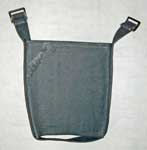 The Pattern 1925 Water Bottle Carrier was introduced with the Web Equipment, R.A.F., Pattern 1925, under Air Ministry Weekly Order No. 793/1927, as Stores Ref. 23/80. It is an envelope type Carrier for the Mk. VI water bottle. It does not have a retaining strap, relying on a tight fit to keep the bottle in place. This same type of Carrier was re-used, in khaki, early on in the Second World War, as it was easier to manufacture. This example is Air Ministry marked, maker marked "M.E. Co.", and dated 1927. From the Karkee Web Collection.
The Pattern 1925 Water Bottle Carrier was introduced with the Web Equipment, R.A.F., Pattern 1925, under Air Ministry Weekly Order No. 793/1927, as Stores Ref. 23/80. It is an envelope type Carrier for the Mk. VI water bottle. It does not have a retaining strap, relying on a tight fit to keep the bottle in place. This same type of Carrier was re-used, in khaki, early on in the Second World War, as it was easier to manufacture. This example is Air Ministry marked, maker marked "M.E. Co.", and dated 1927. From the Karkee Web Collection.
Sleeve type Carriers had previously featured in Mills’ designs, but only in those for Cavalry, so the reasons for this variant featuring in the R.A.F. Pattern are of interest, but are not recorded. The most probable reason dates back to 1918 and the formation of the R.A.F.. Being formerly an Army Corps, their inventory was entirely Army oriented. The issue water bottle was the Bottle, water, enamelled, Mark VI. This was in the standard blue enamelling of the time and had a khaki felt Cover. Whilst this was fine for use with their issue accoutrements, Patt. ’08 W.E., once blue-grey Patt. ’25 W.E. was adopted for Home Service, the Covers did not match. They could not be changed, as Patt. ’08 was the issue for Foreign Service. Mills must therefore have offered cavalry-type sleeve Carriers to conceal the drab (the R.A.F. term) Covers, felt.
In A.P. 1086, Section 19A was changed to Section 23, between the A.M.W.O. announcement of Patt. ’25 and the A.M.W.O. detailing the full Pattern. Stores Ref. 19A/2 BOTTLES, water, enamelled became 23/2 Bottles, water, Mk. VI. At some point thereafter, the Stoppers, Cords and Covers were made separate stores items, the Cover becoming 23/96 BOTTLES, water, enamelled, Covers, felt. The R.A.F. had to wait until after the Second World War, before Blue-grey Covers, cloth were introduced. By that time, Patt. ’08 was obsolete, but the R.A.F. had adopted drab Patt. ’37 W.E. Thereafter they made do – blue-grey covered blue Mark VII bottles in drab Carriers!
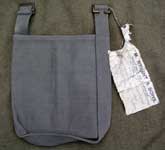
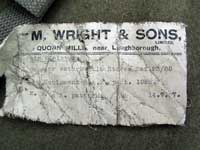 Another interesting example, this one a Working Pattern. Maker marked "M.W. & S. Ltd.". The pattern tag is dated 14.7.37. Photos courtesy of Paul Laidlaw at WD Militaria.
Another interesting example, this one a Working Pattern. Maker marked "M.W. & S. Ltd.". The pattern tag is dated 14.7.37. Photos courtesy of Paul Laidlaw at WD Militaria.

